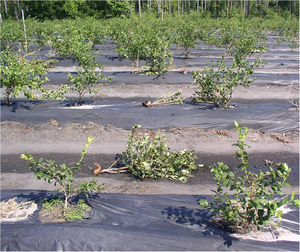Difference between revisions of "Microplastics"
| Line 2: | Line 2: | ||
| − | Most commonly studied for the detrimental effects caused in marine environments, the impacts of '''Microplastics''' on soil ecosystems have been largely neglected [1]. The main sources of microplastic pollution in soil is thought to be plastic mulching film and fertilizer produced through waste water irrigation. | + | Most commonly studied for the detrimental effects caused in marine environments, the impacts of '''Microplastics''' on soil ecosystems have been largely neglected [1]. The main sources of microplastic pollution in soil is thought to be plastic mulching film and fertilizer produced through waste water irrigation[2]. |
| − | |||
| − | |||
| + | ==Plastic Mulching== | ||
| + | [[File:20110829-FSA-XX-0028 - Flickr - USDAgov.jpg|thumb|20110829-FSA-XX-0028 - Flickr - USDAgov]] | ||
| + | Plastic mulch is used to conserve water and subdue weed growth in agriculture. Conventional plastic polymers are typically used as biodegradable alternatives are usually much more expensive [3]. Plastic polymers tend to accumulate in soil as it is broken down due to lack of economical and legal incentive surrounding plastic mulching. | ||
==Potential Impacts on Plant and Soil Health== | ==Potential Impacts on Plant and Soil Health== | ||
| Line 11: | Line 12: | ||
==Refrences== | ==Refrences== | ||
[1]. Defu He, Yongming Luo, Shibo Lu, Mengting Liu, Yang Song, Lili Lei.(2018).Microplastics in soils: Analytical methods, pollution characteristics and ecological risks.TrAC Trends in Analytical Chemistry.163-172.0165-9936.https://doi.org/10.1016/j.trac.2018.10.006. | [1]. Defu He, Yongming Luo, Shibo Lu, Mengting Liu, Yang Song, Lili Lei.(2018).Microplastics in soils: Analytical methods, pollution characteristics and ecological risks.TrAC Trends in Analytical Chemistry.163-172.0165-9936.https://doi.org/10.1016/j.trac.2018.10.006. | ||
| + | |||
| + | [2]Rillig,M.C.(2012).Microplastic in Terrestrial Ecosystems and the Soil?.Environ.Sci.Technol. 46 (12), 6453– 6454, DOI: 10.1021/es302011r | ||
| + | |||
| + | [3]Nizzetto et al (2016): “A theoretical assessment of microplastic transport in river catchments and their retention by soils and river sediments” in Environ. Sci.: Processes Impacts, 2016, 18, 1050-1059. DOI: 10.1039/C6EM00206D | ||
Revision as of 04:19, 6 May 2019
Most commonly studied for the detrimental effects caused in marine environments, the impacts of Microplastics on soil ecosystems have been largely neglected [1]. The main sources of microplastic pollution in soil is thought to be plastic mulching film and fertilizer produced through waste water irrigation[2].
Plastic Mulching
Plastic mulch is used to conserve water and subdue weed growth in agriculture. Conventional plastic polymers are typically used as biodegradable alternatives are usually much more expensive [3]. Plastic polymers tend to accumulate in soil as it is broken down due to lack of economical and legal incentive surrounding plastic mulching.
Potential Impacts on Plant and Soil Health
Refrences
[1]. Defu He, Yongming Luo, Shibo Lu, Mengting Liu, Yang Song, Lili Lei.(2018).Microplastics in soils: Analytical methods, pollution characteristics and ecological risks.TrAC Trends in Analytical Chemistry.163-172.0165-9936.https://doi.org/10.1016/j.trac.2018.10.006.
[2]Rillig,M.C.(2012).Microplastic in Terrestrial Ecosystems and the Soil?.Environ.Sci.Technol. 46 (12), 6453– 6454, DOI: 10.1021/es302011r
[3]Nizzetto et al (2016): “A theoretical assessment of microplastic transport in river catchments and their retention by soils and river sediments” in Environ. Sci.: Processes Impacts, 2016, 18, 1050-1059. DOI: 10.1039/C6EM00206D
